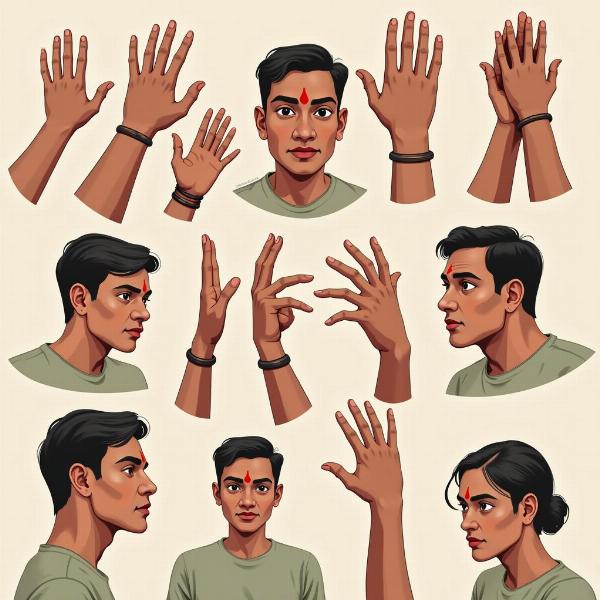Understanding the meaning of a simple wave can be surprisingly complex, especially across different cultures. When you’re trying to figure out “waved at you meaning in Hindi,” it goes beyond a simple translation. It’s about understanding the context, the relationship between the individuals, and the subtle nuances of body language that accompany the gesture. This article explores the various ways waving is interpreted in Hindi and Indian culture, providing a deeper understanding beyond a basic dictionary definition.
Decoding the Wave: Different Types and Their Meanings
In India, as in many cultures, a wave can communicate a range of emotions, from a casual hello to a heartfelt goodbye. Let’s explore some common types of waves and their interpretations within the Indian context.
The Casual Hello: “Namaste” and the Head Bobble
A gentle wave, often accompanied by a slight head bobble or tilt, is a common way of acknowledging someone in India. This gesture often replaces a verbal greeting and can be considered the equivalent of a casual “hello” or “hi.” It’s a polite and respectful way to acknowledge someone’s presence without being overly intrusive. This gesture is especially common when passing someone you know on the street or in a public place.
The Formal Farewell: “Alvida” with a Raised Hand
A more formal farewell might involve a raised hand with a slow, deliberate wave. This gesture, often accompanied by a verbal “alvida” (goodbye), signifies a more significant parting. It suggests a longer separation and a more profound sense of farewell than the casual hello.
The Beckoning Wave: Calling Someone Over
A downward-facing wave with the palm facing down and fingers curling inwards is often used to beckon someone to come closer. This gesture can be seen in various settings, from a parent calling their child to a shopkeeper gesturing a customer. While commonly used, it’s important to be mindful of the context, as in some situations it can be perceived as slightly impolite, especially when directed towards elders.
Context is Key: Understanding Nonverbal Communication
When trying to decipher “waved at you meaning in Hindi,” remember that nonverbal cues play a significant role. Facial expressions, eye contact, and overall body language can drastically alter the interpretation of a simple wave. A warm smile coupled with a wave conveys friendliness, while a stern expression might suggest disapproval or a warning. heran meaning in hindi
Regional Variations: Navigating Cultural Nuances
It’s essential to note that even within India, regional variations in gestures exist. What might be considered a polite gesture in one region could have a different connotation in another. Therefore, paying attention to the specific cultural context is crucial for accurately interpreting nonverbal communication.
Beyond the Wave: Other Common Indian Gestures
While the wave is a common gesture, understanding other Indian nonverbal cues can further enrich your communication skills. The head shake, for example, can have various meanings depending on the context and the angle of the head movement. It could signify agreement, disagreement, or even a simple acknowledgment. meaning of ved in hindi
 Common Indian Gestures
Common Indian Gestures
Conclusion: Mastering the Art of Nonverbal Communication in Hindi
Understanding “waved at you meaning in Hindi” requires going beyond a literal translation and delving into the rich tapestry of Indian culture and nonverbal communication. By considering the context, relationship, and accompanying body language, you can accurately interpret the nuances of this seemingly simple gesture. This knowledge will not only enhance your understanding of Indian culture but also improve your communication skills within this diverse and vibrant society. waved ka hindi meaning
FAQ: Common Questions about Waving in India
- Does a wave always mean hello in India? Not necessarily. The meaning can vary based on the type of wave, the context, and accompanying body language.
- Is it considered rude to beckon someone with a downward-facing wave? While commonly used, it can be perceived as slightly impolite in certain situations, especially towards elders. It’s best to exercise caution.
- What are some other common Indian gestures? The head shake, theNamaste greeting, and various hand gestures play important roles in Indian nonverbal communication.
- How can I learn more about Indian nonverbal communication? Observing people, asking questions, and immersing yourself in the culture are excellent ways to learn more.
- Why is understanding nonverbal communication important in India? Nonverbal cues often convey more meaning than words, particularly in a culture as rich in tradition and nuance as India.
- Is it okay to wave at strangers in India? A casual wave or head bobble is generally acceptable as a polite acknowledgment.
- Are there regional variations in Indian gestures? Yes, different regions have unique nonverbal cues, highlighting the diversity of Indian culture. parting words meaning in hindi
Meaning-Hindi.in specializes in accurate and culturally sensitive Hindi translation services, catering to diverse needs from business and legal documents to website localization and technical manuals. Our expertise spans various fields, ensuring precise and nuanced translations that bridge language barriers. Contact us for your Hindi translation needs at [email protected] or +91 11-4502-7584. Meaning-Hindi.in is your trusted partner for professional Hindi translation services.